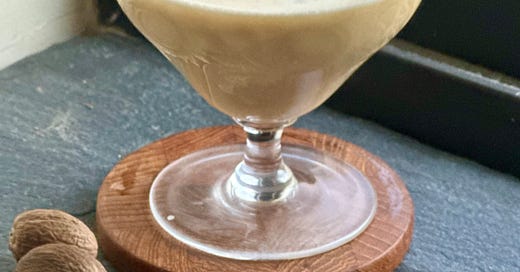Around this time of year, we usually make eggnog.
After all, it’s a Christmas drink, made for the holiday season. Indeed, in its heyday in the early 1800s, it was common for households in the mid-Atlantic region to serve up a big batch of boozy eggnog on Christmas morning. Personally, I’ve never been a big fan of early-morning cocktails, but that’s certainly one way to get your holiday celebration started.
In the past, we’ve made a Black Walnut Manhattan Eggnog, a Boulevardier Eggnog (with Cynar!), and even just plain old regular eggnog. If you want to make a batch of one of these egnogs for Christmas, you should probably start now.
There are a lot of good ways to make eggnog. Like so many cocktails that have endured, it’s a versatile format as much as a specific drink.
But all of the eggnogs we’ve made so far have been large batch eggnogs, designed to serve a group, or to remain bottled in your fridge for the entire holiday season, ready to serve at the right occasions.
Batched eggnogs in this style take a day or so to rest before you can consume them, and they’re best after a few weeks, or even a few months, of aging in the refrigerator. In other words, they take fridge space, and they take time.
Yet it’s possible to make a single serve eggnog with minimal prep time. This one and done eggnog is ready to drink in about a minute (after you gather the ingredients).
Single serve eggnog isn’t quite as decadently creamy as batched eggnog, since it’s chilled via a conventional shake with ice, which also adds water/dilution to the mix. But it’s still rich, sweet, eggy, and delicious, a dessert-friendly cocktail that marries wintry booze with egg, cream, and sugar. And because it comes in a smaller form-factor, it allows you to taste, tweak, and experiment at lower risk than a big-batch drink.
The a la minute preparation, meanwhile, makes for faster, easier, lower-risk experimentation. It also means you don’t have to store a bottle — or several increasingly elderly bottles that you may have promised to remove 10 months ago, uh, sorry honey? — in the fridge for weeks upon weeks during the holiday season.
It’s convenience eggnog, starter eggnog, maybe even dilettante eggnog — a low-commitment eggnog for the home bartender who isn’t sure about going all in.
If you’ve ever wanted to try making eggnog, but didn’t want to blend, bottle, and store a party-sized batch, this is the eggnog for you. This is also a great option for people who really like eggnog but just want a single serving or two throughout the holiday season rather than an entire bottle.
Also, it combines rum with bourbon (or brandy), and it’s so good you’ll probably want to make more than one.
So this week, we will…
go over what defines eggnog
then discuss how to balance the various ingredients
look at some methods for fine-tuning and adjust single-serve eggnogs
and finally, we’ll make my favorite single-serve eggnog.
Flip You For Real
Fundamentally, eggnog is just a subcategory of flip. A flip, longtime readers may recall, is a cocktail shaken with a whole egg, plus some sort of syrup or comparable sweetener.
The big difference between a flip and eggnog is that eggnog also involves cream and/or milk, taking it a little more in the direction of ice cream.
For our larger batched eggnogs, we use a blender or stand mixer to combine eggs, sugar, whole milk, and heavy cream with some sort of booze — rum and brandy are common, as is sherry, but you can make weirder versions too.
For our single serve eggnog, we’re going to pare that down to just three primary non-booze ingredients:



